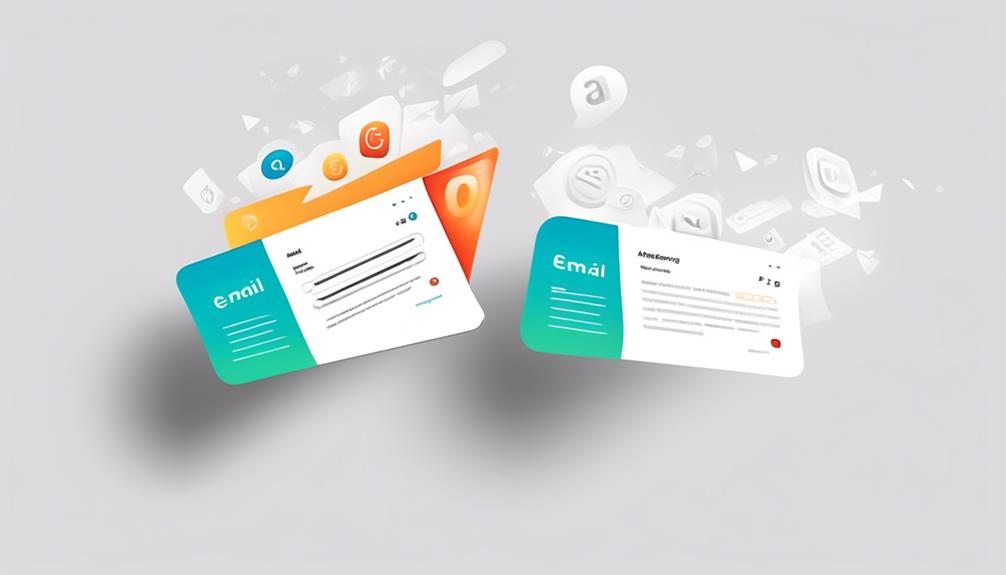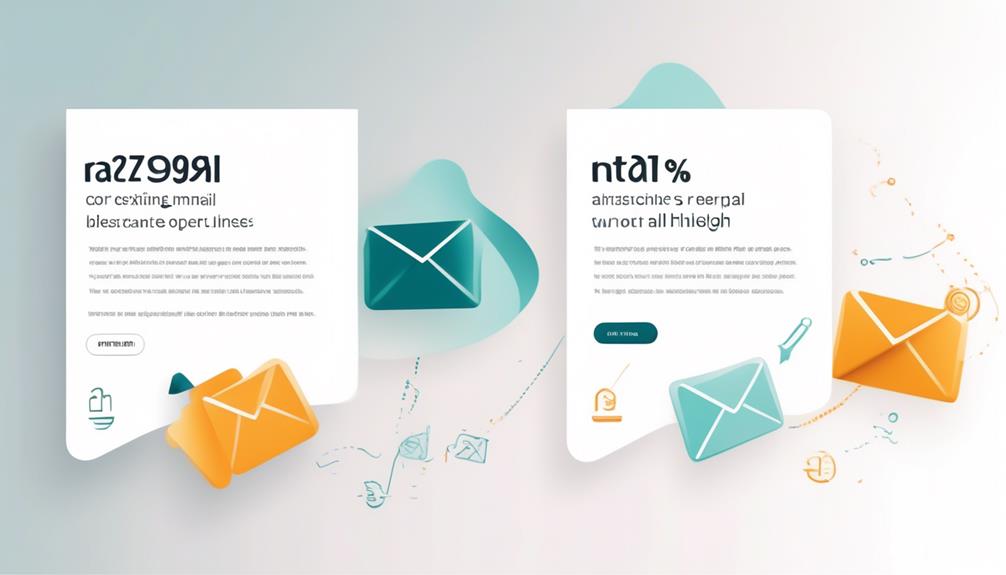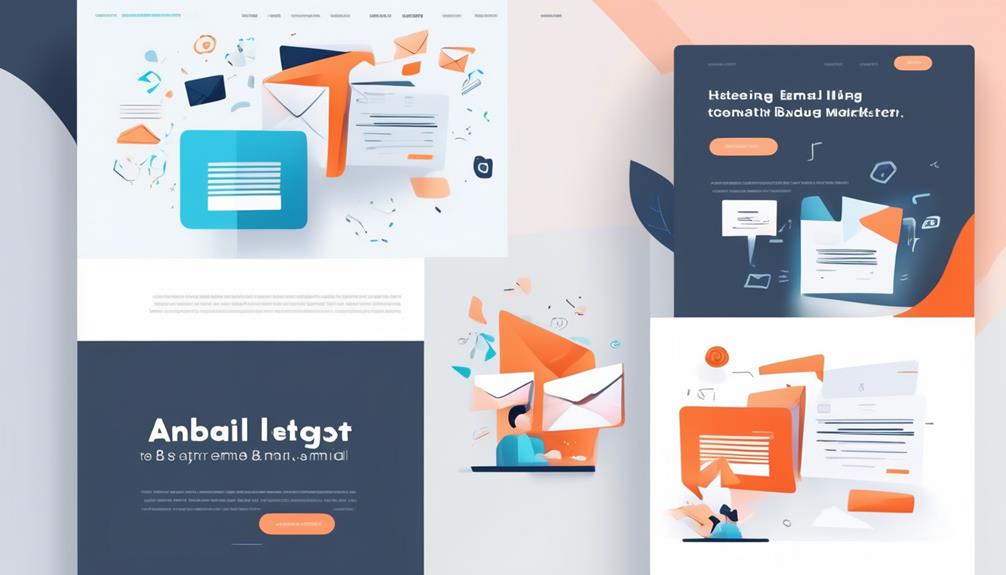As marketing experts, we are constantly faced with the challenge of setting ourselves apart in saturated email environments, competing for attention among a large number of competitors. It may seem daunting, but with the right strategies, this can be effectively handled.
A/B testing is a powerful tool that allows us to compare different elements of our emails to understand what resonates best with our audience. But what are the top strategies for A/B testing that can truly elevate the success of our email campaigns?
Let's explore the key techniques and best practices that can make all the difference in driving higher engagement and conversions.
Key Takeaways
- A/B testing for email is crucial for optimizing open and click-through rates, preventing poor email deliverability, and identifying the impact of different campaign elements.
- Key variables to test include subject lines, offers and CTAs, design and format, email length, and time of day and frequency.
- Best practices for A/B testing involve focusing on key elements like subject lines, call to action, and design layout, analyzing data to make data-driven decisions, and continuously testing and optimizing email campaigns.
- Strategies and tools for A/B testing include subject line testing, content variation testing, and utilizing essential email testing tools like Litmus, Mailchimp, and Campaign Monitor.
What Is A/B Testing for Email?
A/B testing for email, also known as split testing, is a strategic method used by marketers to experiment with different variations of emails in order to determine the most effective approach for improving open and click-through rates. This involves testing two versions of an email with slight variances, such as subject lines, to understand audience preferences and optimize campaign performance. By conducting A/B testing, marketers can gain valuable insights into what resonates with their audience, ultimately leading to improved email open rates, click-through rates, website traffic, and conversion rates.
The statistical significance of A/B testing can't be overstated, as it allows marketers to make data-driven decisions. Neglecting A/B testing can lead to poor email deliverability and readability, highlighting the significant impact of this strategy on email marketing success. It provides a clear understanding of email metrics, enabling the optimization of email campaigns for maximum impact.
Ultimately, A/B testing helps marketers to not only increase engagement and conversions but also to gain a deeper understanding of audience behavior and preferences, leading to more effective and targeted email strategies.
Importance of Email A/B Testing
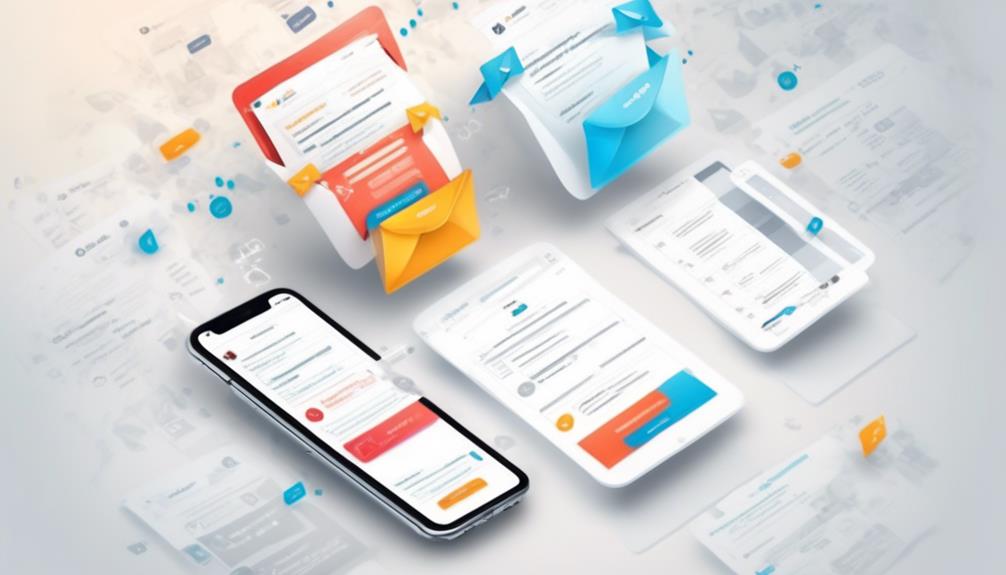
A/B testing is essential for optimizing email campaigns to achieve higher open rates, click-through rates, and conversions.
By analyzing data from A/B tests, we can make strategic decisions to improve campaign performance.
The impact of A/B testing on email success can't be overstated, as it allows us to make data-driven adjustments that lead to significant improvements in engagement and revenue.
Testing Impact
Utilizing email A/B testing is essential for gauging the impact of various elements on campaign outcomes, enabling data-driven decisions and improved engagement. A/B testing significantly influences open and click-through rates, leading to increased website visitors and conversions.
Neglecting A/B testing can result in poor email deliverability, decreased engagement, and missed revenue opportunities. This testing method helps identify the impact of subject lines, offers, design, and copy on campaign outcomes, leading to more effective email marketing strategies.
Marketers can make data-driven decisions based on empirical results, improving engagement, conversions, and revenue. Small changes in emails, such as using a personalized sender name or testing different CTAs, can lead to significant improvements in engagement rates and revenue.
- Optimizes open and click-through rates
- Prevents poor email deliverability and decreased engagement
- Identifies the impact of various campaign elements
- Enables data-driven decisions and improved engagement
- Small changes lead to significant improvements in engagement and revenue
Data-Driven Decisions
With the data-driven insights gained from A/B testing, we can make informed decisions to optimize email campaign performance and engagement. By analyzing A/B test results, we can identify statistically significant differences in open rates, click-through rates, and conversion rates. This allows us to experiment with different email variables such as subject lines, offers, design, and copy to understand their impact on customer engagement and conversions. Utilizing customer data to drive our email marketing decisions ensures that our campaigns are tailored to maximize performance and lead to increased revenue. The table below summarizes the key benefits of data-driven decisions through A/B testing.
| Benefits of Data-Driven Decisions |
|---|
| Identify statistically significant differences |
| Experiment with different email variables |
| Tailor campaigns for maximum performance |
| Increase customer engagement |
| Drive increased revenue |
Key Variables for Email A/B Testing
Testing different variables in email A/B testing is crucial for optimizing the effectiveness of email campaigns. When conducting A/B testing for email marketing, it's essential to consider various key variables to ensure the best possible results. These variables include:
- Subject line: Testing different lengths, personalization, and the use of emojis can significantly impact open rates.
- Offers and CTAs: Testing different types of offers, discounts, and call-to-action placements and designs can influence conversion rates.
- Design and format: Testing plain-text vs. HTML emails, use of images, and interactive design elements can affect engagement and click-through rates.
- Email length: Testing shorter emails for simplicity or longer emails with more details can impact reader engagement and conversion rates.
- Time of day and frequency: Testing different send times and days to maximize open and click-through rates is crucial for achieving optimal results.
10 Best Practices for A/B Testing
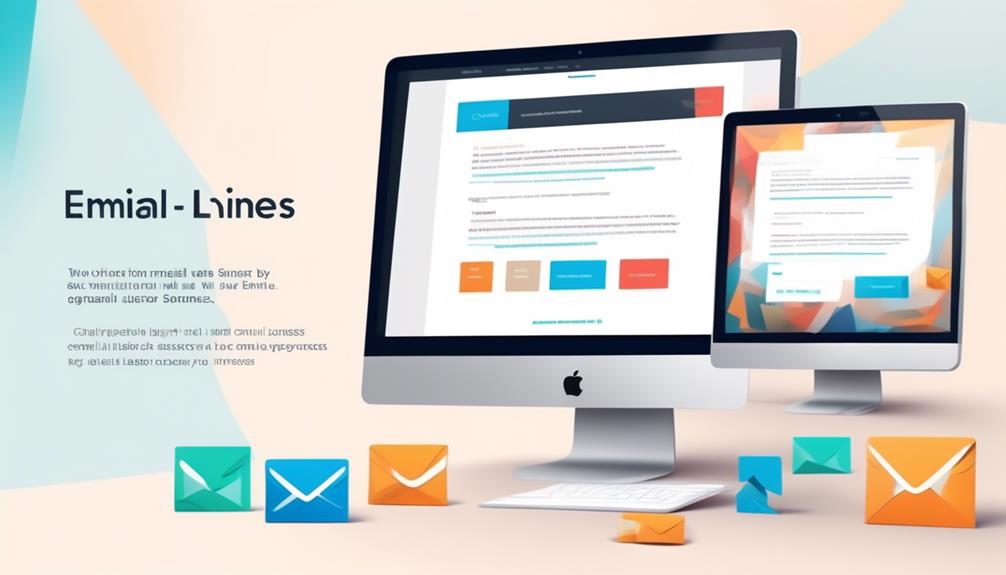
When it comes to A/B testing, we focus on key elements such as subject lines, call to action, and design layout.
These factors play a critical role in determining the effectiveness of email campaigns.
Subject Lines
In A/B testing strategies for email success, subject lines play a pivotal role in engaging recipients and driving open rates. When A/B testing subject lines, consider testing different lengths, personalization, and the use of emojis. Experiment with various types of offers, discounts, and call-to-action placements and designs.
Test plain-text versus HTML emails, use of images, and interactive design elements. Additionally, consider testing shorter emails for simplicity or longer emails with more details. Finally, test different send times and days to maximize open and click-through rates.
A/B testing subject lines can provide valuable insights into what resonates with your audience, ultimately leading to improved open rates, conversion rates, and overall email success for email marketers and their email copy.
Call to Action
As we consider the impact of effective subject lines on driving open rates and engagement, attention shifts to the critical element of the call to action (CTA) in email A/B testing strategies for maximizing click-through rates and conversions. A/B testing different CTA placements, designs, wording, personalized CTAs, urgency, offers, and button optimization can determine the most effective approach for encouraging action. By testing the impact of various elements, we can refine the effectiveness of email campaigns and understand audience preferences. Below is a table summarizing the key aspects to consider when A/B testing CTAs in emails:
| A/B Testing Elements for CTAs | Examples | Impact on Performance |
|---|---|---|
| Placement and Design | Above the fold vs. Below | Click-through rate impact |
| Wording and Personalization | Generic vs. Personalized | Conversion rate influence |
| Urgency and Offers | Limited time vs. Evergreen | Engagement and response rates |
| Button Optimization | Color, Shape, Size | Influence on engagement |
Design Layout
Design layout A/B testing provides valuable insights into the most effective and engaging email visual arrangements. This allows for optimization of open rates, click-through rates, and overall campaign performance.
When conducting A/B testing for email design layout, consider experimenting with plain text versus HTML versions of your email to gauge recipient preferences.
Testing the use of images in your email can help determine the impact on engagement and conversion rates.
Additionally, incorporating elements like social proof and animated GIFs in the design layout can be tested to assess their influence on recipient interaction.
Furthermore, testing different email templates and layouts enables the identification of the most visually appealing and effective design for driving engagement and conversions.
Improving Email Performance With A/B Testing
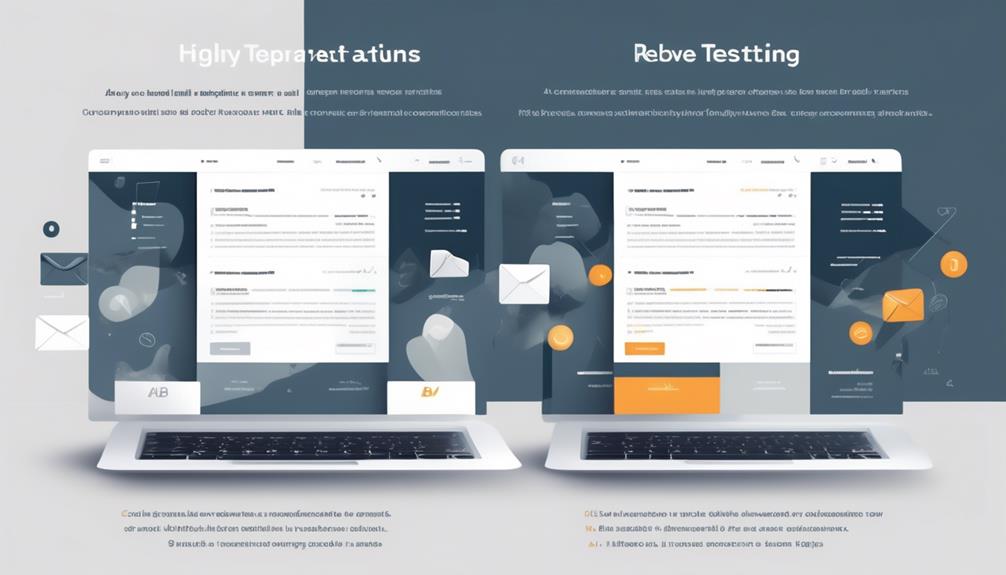
To enhance email performance through A/B testing, we meticulously analyze and optimize various campaign elements for maximum impact. A/B testing is a powerful tool for improving email performance, as it allows us to test different variables and identify the most effective strategies for increasing open rates, click-through rates, and conversion rates. By testing elements such as subject lines, email content, calls to action, and timing, we can gain valuable insights into what resonates most with our audience.
One of the key benefits of A/B testing email campaigns is the ability to make data-driven decisions. By collecting empirical results from A/B tests, we can refine our email strategies to better engage recipients and drive desired actions. A/B testing also enables us to optimize transactional emails, ensuring that crucial communications are effective in achieving their objectives.
Furthermore, A/B testing helps us identify and address potential issues that may impact email performance, such as poor deliverability and readability. By continuously testing and refining our email campaigns, we can maintain high open rates and engagement levels, ultimately contributing to the overall success of our email marketing efforts.
A/B Testing Stats to Consider
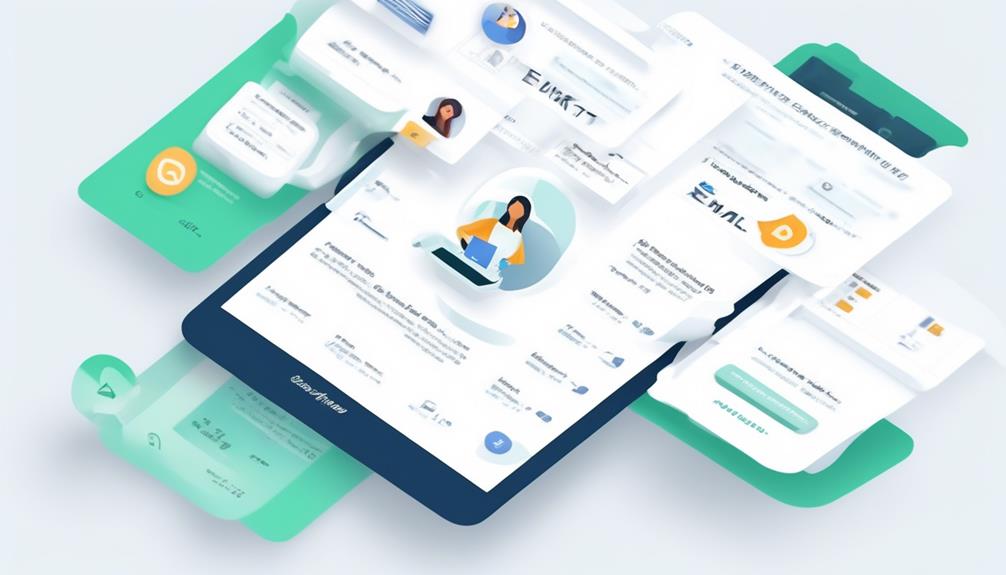
Despite the proven impact of A/B testing on email performance, a staggering 39% of brands neglect to test their broadcast or segmented emails, potentially missing out on valuable insights and optimization opportunities.
When considering A/B testing stats for email success, it's crucial to analyze the following data points:
- Open Rate Variations: A/B testing can reveal which subject lines, sender names, or email content lead to higher open rates, providing valuable insights for optimizing future campaigns.
- Conversion Rates: Testing different calls to action, visuals, or copy can help identify the best-performing elements that drive higher conversion rates, ultimately boosting the effectiveness of email marketing efforts.
- Email Client Compatibility: Understanding how different email clients render your emails can help optimize the design and layout for better user experience across various platforms and devices.
- eCommerce Email Optimization: A/B testing can uncover the most effective strategies for driving sales, such as product recommendations, promotional offers, and personalized content.
- Impactful Changes: Even small adjustments, such as tweaking the email copy, images, or CTAs, can yield significant improvements in engagement rates and revenue generation.
Tips for Effective A/B Tests
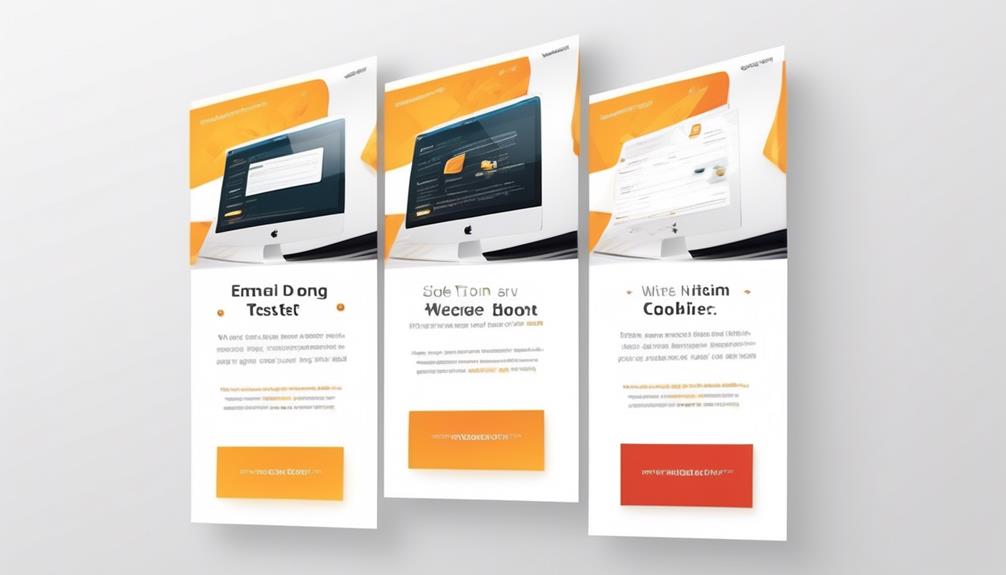
When conducting A/B tests for email campaigns, we focus on key elements such as subject lines and content variation. These two areas play a crucial role in determining the success of our email marketing efforts.
Subject Line Testing
Using A/B testing, marketers can evaluate the effectiveness of different subject line elements to optimize email engagement. Here are some Email A/B Testing Ideas for subject line testing:
- Vary word length, use of emojis, and tone in subject lines to test for effective engagement
- Experiment with different types of offers, discounts, and call-to-action placements and designs to optimize open and click-through rates
- Test plain-text vs. HTML emails, use of images, and interactive design elements for better email performance
- Experiment with different send times and days to maximize open and click-through rates
- Test the impact of personalized content and recommendations to understand audience preferences
Subject line testing is crucial in determining the best approach to catch the audience's attention and drive better email performance.
Content Variation Testing
In conducting content variation testing for email campaigns, we aim to strategically optimize the effectiveness of different content elements through A/B testing. By testing different variations such as subject lines, offers, design, email length, and personalization, we can determine the most impactful elements.
This testing can lead to higher open rates, click-through rates, website traffic, conversions, and reduced unsubscribe rates. Neglecting content variation testing can result in poor email deliverability and readability, impacting overall campaign success.
Furthermore, effective content variation testing enhances the technical side of email marketing, ensuring emails appear correctly on different devices and platforms. It's crucial to experiment with different versions of emails to identify the most compelling content that resonates with subscribers, ultimately boosting engagement and conversion rates.
Essential Email Testing Tools

To enhance email campaign performance through A/B testing, leveraging essential email testing tools is imperative for achieving meaningful insights and impactful results. When it comes to A/B testing your emails, the following tools are crucial for optimizing your email marketing strategy:
- Subject Line Testing: Utilize tools like Litmus or CoSchedule to A/B test different subject lines and determine which ones lead to a higher open rate.
- Personalization Testing: Test the impact of including the recipient's first name in the subject line or body of the email using tools like Mailchimp or HubSpot.
- Timing Testing: Experiment with different open times to send emails and identify the optimal timing for your audience using tools like Sendinblue or Constant Contact.
- Content Length Testing: Test the impact of email length on engagement using tools like AWeber or GetResponse to determine the ideal email length for your audience.
- Offer Testing: Use tools like Campaign Monitor or SendGrid to A/B test different offers, such as free shipping or percentage discounts, to see which resonates more with your subscribers.
These tools provide actionable insights for implementing successful A/B test ideas and driving higher engagement and conversions.
A/B Testing Wrap-Up
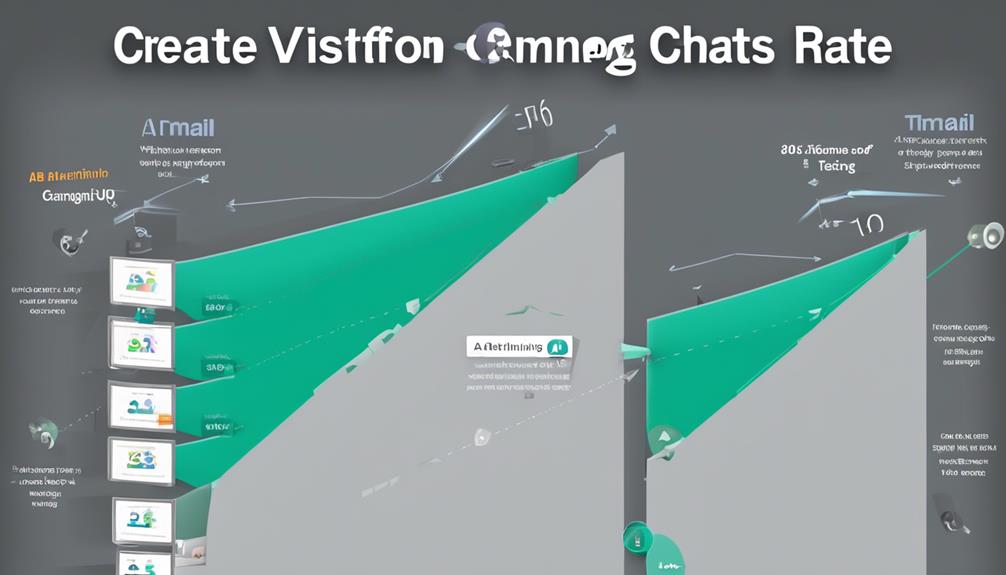
Upon completion of A/B testing, the analysis of results becomes pivotal for determining the most effective strategies and elements in email marketing. It's imperative to closely examine the data from A/B testing to make informed decisions that enhance email success.
Analyzing conversion rates, open rates, and click-through rates is essential for identifying the winning version of the email campaign. Creating two versions, such as testing different subject lines or content variations, allows for a comprehensive comparison of performance metrics.
A common mistake in A/B testing wrap-up isn't considering a sufficiently large sample size, which can lead to unreliable results. Therefore, ensuring a statistically significant sample size is crucial for drawing accurate conclusions from the test data.
The A/B testing wrap-up phase is where the empirical evidence gathered during the testing process is transformed into actionable insights. This data-driven approach enables strategic decision-making and optimization of future email marketing campaigns.
Common Questions About A/B Testing
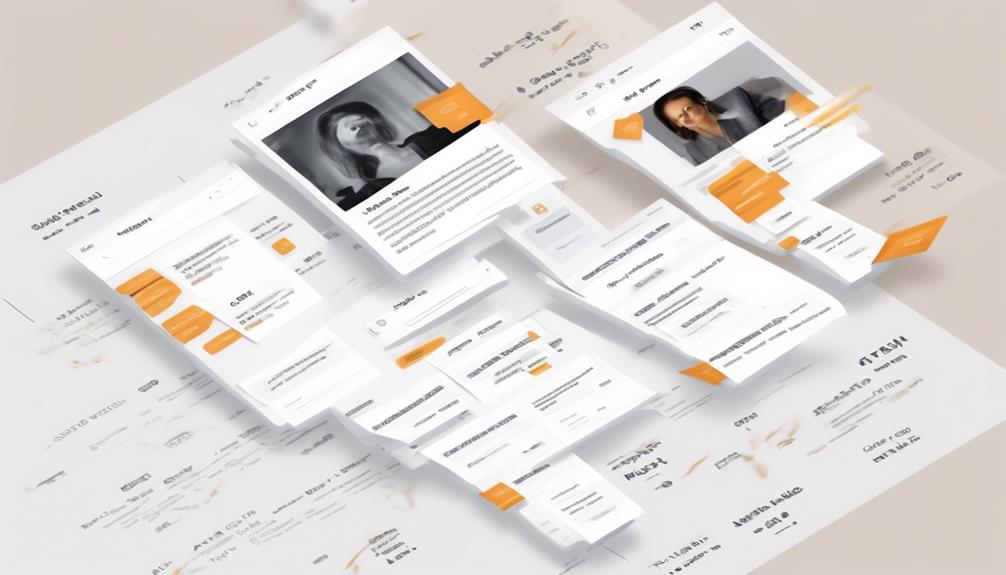
After deriving actionable insights from the A/B testing wrap-up phase, we can now address the common questions about A/B testing to further enhance our email marketing strategies.
- What're the most critical elements to A/B test in marketing emails?
- How can we mitigate the impact of confounding variables in A/B tests?
- What strategies can we employ to improve conversion rates through A/B testing?
- When should we consider the control version as the winning variant in A/B testing?
- What're the best practices for A/B testing subject lines to maximize email open rates?
Addressing these common questions is crucial for mastering A/B testing and leveraging it to drive email success.
By understanding the key elements to test, mitigating confounding variables, and honing strategies to improve conversion rates, marketers can optimize the performance of their marketing emails.
Additionally, knowing when to deem the control version as the winning variant and implementing best practices for testing subject lines are essential for achieving higher open rates and click-through rates.
Starting Email A/B Testing
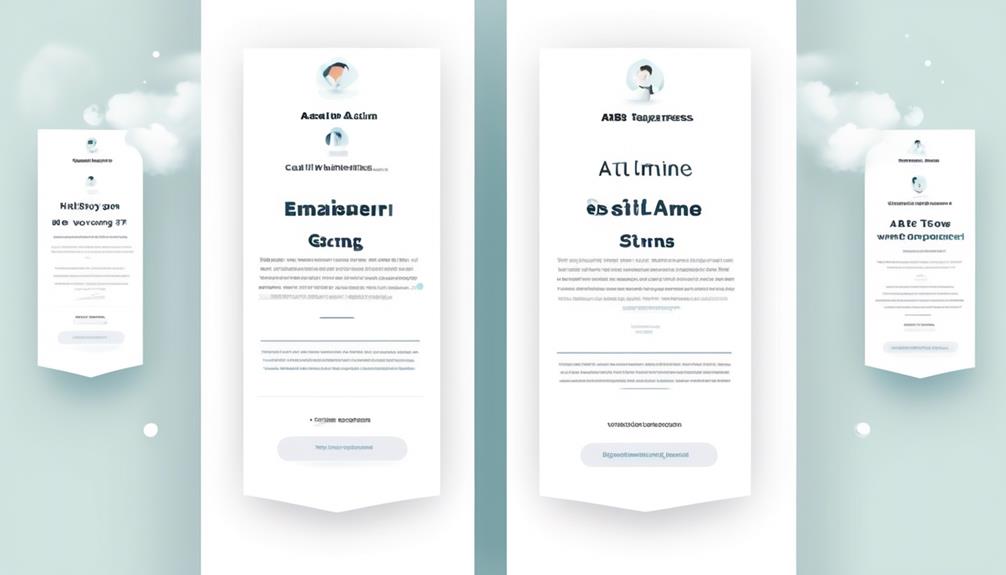
When commencing email A/B testing, it's imperative to carefully select the specific elements to be tested in order to yield actionable insights and optimize email campaign performance.
One key variable to test is the subject line, as it plays a crucial role in determining open rates. Campaign Monitor reported that emails with personalized subject lines generate 26% more unique open rates.
Additionally, testing different calls to action, images, or even the email layout can significantly impact conversion rates and ultimately revenue. By focusing on these variables, marketers can gain valuable insights into what resonates best with their audience.
It's important to remember that the goal of A/B testing isn't just to identify the winning version, but to understand why it performs better. This data-driven approach enables continuous improvement and refinement of email marketing strategies.
Neglecting A/B testing means missing out on opportunities to enhance email campaign effectiveness, potentially leading to decreased revenue and engagement. Therefore, starting email A/B testing with a strategic and analytical mindset is fundamental for achieving long-term success.
What are the Best A/B Testing Strategies for Email Open Rate Success?
When attempting to increase email open rates, it’s crucial to utilize effective A/B testing strategies. Try testing different subject lines, email send times, or even the sender’s name. Analyze the data and make adjustments based on what resonates with your audience to achieve email open rate success.
Frequently Asked Questions
What Is Email AB Testing Strategy?
We define email A/B testing as the method to experiment with different email versions. Marketers test two versions with slight variances to determine the winning one.
It's crucial for understanding audience preferences and optimizing campaign performance. Variables like subject lines are tested to identify what resonates with the audience. The goal is to improve email open rates and click-through rates.
A/B testing is an essential tool for continuous improvement in email marketing.
What Is the Best Email Strategy?
We believe the best email strategy involves leveraging A/B testing to optimize open and click-through rates through data-driven decision-making.
By testing variables like subject lines, offers, design, and timing, we continuously challenge and refine our approach.
This approach allows us to make informed, strategic decisions, ensuring our email campaigns are continuously optimized for better performance and audience engagement.
How Do You Do an Effective Ab Test?
We maximize email campaign success through effective A/B testing.
By sending different variations to subsets of subscribers, we identify winning versions. Testing variables like subject lines improves audience resonance and campaign performance.
A/B testing optimizes open rates, click-through rates, website traffic, conversions, and decreases unsubscribe rates.
Neglecting A/B testing impacts email deliverability and readability.
It's crucial for data-driven decisions and achieving better email marketing results.
How Do You Measure the Success of an Ab Test?
We measure the success of an A/B test by analyzing key performance indicators such as open rates, click-through rates, conversions, and unsubscribe rates. By comparing these metrics between the control and variant groups, we can determine which version yields the best results.
Additionally, we consider statistical significance to ensure the validity of our findings. This data-driven approach allows us to make informed decisions and continuously optimize our email campaigns for success.
Conclusion
Just as a ship's captain uses a compass to navigate through rough waters, marketers can use A/B testing to steer their email campaigns towards success.
By analyzing data and strategically testing different variables, we can chart a course for higher open and click-through rates, increased conversions, and improved email performance.
A/B testing is the compass that guides us towards the optimal path for email success.
